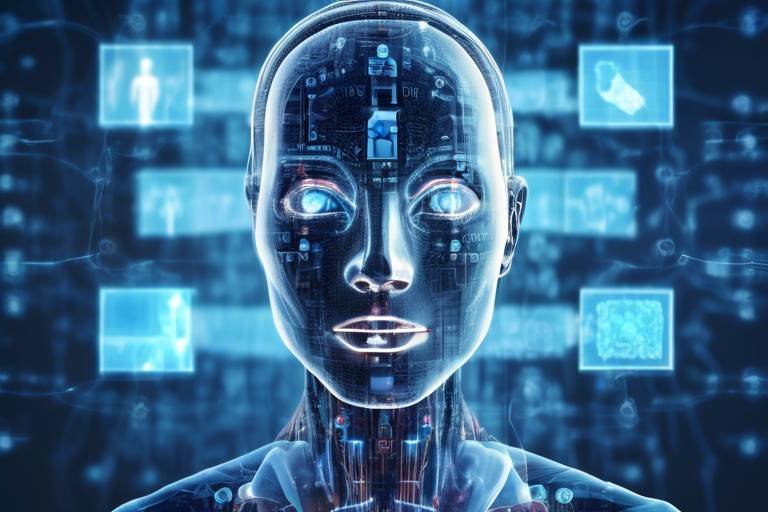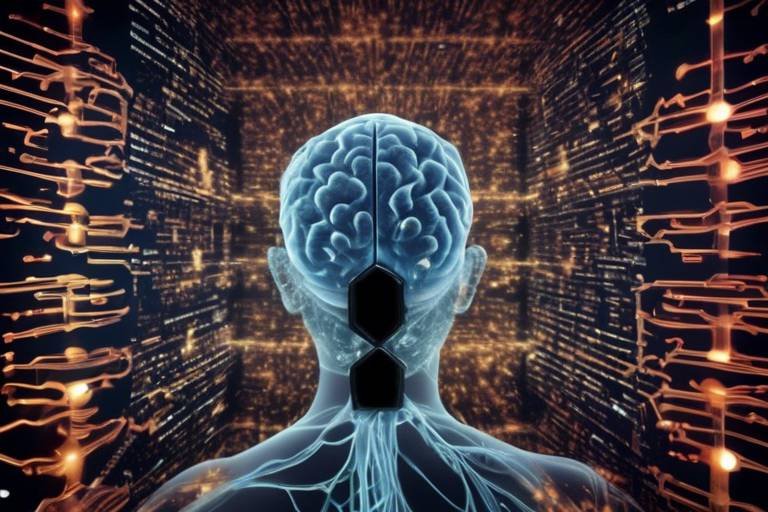The Role of AI in Enhancing Cybersecurity Measures
In today's digital age, the landscape of cybersecurity is evolving at an unprecedented pace. With the increasing reliance on technology, organizations are more vulnerable than ever to cyber threats. This is where artificial intelligence (AI) comes into play, transforming the way we approach cybersecurity. By leveraging AI, businesses can not only identify vulnerabilities but also enhance their threat detection and response capabilities. Imagine having a digital watchdog that never sleeps, constantly analyzing and adapting to new threats while you focus on your core business operations. Sounds revolutionary, right? Let's dive deeper into how AI is reshaping the cybersecurity realm.
Before we can appreciate the role of AI, it’s essential to understand the various types of cyber threats that organizations face today. Cyber threats come in many forms, including malware, phishing attacks, and ransomware. Each of these threats poses unique challenges and can have devastating impacts on security. For instance:
- Malware: Malicious software designed to disrupt, damage, or gain unauthorized access to computer systems.
- Phishing Attacks: Deceptive attempts to obtain sensitive information by pretending to be a trustworthy entity.
- Ransomware: A type of malware that encrypts a victim's files and demands payment for the decryption key.
The impact of these threats is profound, often resulting in financial loss, reputational damage, and legal complications. This reality underscores the need for advanced protective measures, making AI an invaluable ally in the fight against cybercrime.
AI technologies are revolutionizing threat detection by analyzing vast amounts of data in real-time. Traditional methods often fall short due to the sheer volume and complexity of data that organizations generate. However, with AI, machine learning algorithms can identify patterns and anomalies that human analysts might miss. Imagine a vast ocean of data, and AI is the skilled fisherman who knows exactly where to cast the net to catch the most significant threats.
At the heart of AI-powered cybersecurity are machine learning algorithms. These algorithms continuously learn from new data, evolving to improve threat detection accuracy over time. They analyze everything from user behavior to network traffic, identifying trends that can indicate potential security breaches. This dynamic learning process ensures that organizations stay one step ahead of cybercriminals.
When it comes to machine learning, there are two primary techniques: supervised learning and unsupervised learning. Supervised learning involves training algorithms on labeled datasets, allowing them to make predictions based on historical data. In contrast, unsupervised learning identifies patterns in data without predefined labels, making it particularly useful for detecting unknown threats. Both techniques play critical roles in identifying and mitigating cyber threats effectively.
Another exciting development in AI is the emergence of adaptive learning systems. These systems utilize feedback loops to refine their security measures continually. Think of them as a personal trainer for your cybersecurity protocols—constantly assessing performance and making adjustments to enhance resilience against evolving cyber threats.
Behavioral analysis is another crucial aspect of AI in cybersecurity. By monitoring user behavior, AI can identify deviations that may indicate a security threat. For example, if an employee suddenly accesses sensitive files at odd hours, this could trigger an alert. This proactive approach to security allows organizations to respond to potential threats before they escalate into serious incidents.
In the event of a cyber attack, time is of the essence. Automation in incident response significantly reduces reaction times, allowing organizations to respond swiftly and effectively. AI streamlines processes, enabling teams to focus on strategic decision-making rather than getting bogged down in manual tasks. Imagine a fire alarm that not only alerts you to danger but also automatically dispatches the fire department—this is the kind of efficiency AI brings to cybersecurity.
AI-driven playbooks provide structured responses to specific incidents, enhancing efficiency and consistency in handling cybersecurity incidents. These playbooks outline step-by-step actions that teams should take in response to various threats, ensuring that everyone knows their role during a crisis. This level of preparedness can make all the difference in mitigating the impact of a cyber attack.
While AI offers powerful tools for cybersecurity, it’s essential to remember that human expertise remains vital. The collaboration between AI technologies and cybersecurity professionals is crucial in strengthening defenses. AI can handle data analysis and threat detection, but human intuition and experience are irreplaceable when it comes to understanding the broader context of a cyber threat. Together, they create a formidable defense against cybercrime.
- What is AI in cybersecurity? AI in cybersecurity refers to the use of artificial intelligence technologies to enhance threat detection, response, and overall security measures.
- How does AI improve threat detection? AI improves threat detection by analyzing large datasets in real-time, identifying patterns and anomalies that indicate potential threats.
- Can AI completely replace human cybersecurity professionals? No, while AI can automate many processes, human expertise is essential for strategic decision-making and understanding complex threats.
- What are machine learning algorithms? Machine learning algorithms are computational models that learn from data to make predictions or decisions without being explicitly programmed.

Understanding Cyber Threats
In today's digital age, the landscape of cyber threats is constantly evolving, presenting a myriad of challenges for organizations of all sizes. Cybercriminals are becoming increasingly sophisticated, employing advanced techniques to exploit vulnerabilities in systems and networks. Let's take a closer look at some of the most prevalent types of cyber threats that organizations face today.
One of the most notorious threats is malware, a blanket term that encompasses various malicious software designed to harm, exploit, or otherwise compromise a computer system. Malware can take many forms, including viruses, worms, and trojan horses. Each type has its own method of infiltration and impact, but they all share the common goal of disrupting operations and stealing sensitive information.
Another significant threat is phishing attacks. These attacks often come in the form of deceptive emails or messages that appear to be from reputable sources, luring unsuspecting users into providing personal information or clicking on malicious links. Phishing is particularly alarming because it preys on human psychology, exploiting trust and urgency to trick individuals into compromising their own security.
Then, we have ransomware, which has gained notoriety for its devastating impact on organizations. This type of malware encrypts a victim's files, rendering them inaccessible until a ransom is paid to the attacker. The consequences of a ransomware attack can be catastrophic, leading to significant financial losses, reputational damage, and potential legal ramifications.
It's essential to understand that these threats do not operate in isolation. Cybercriminals often combine various tactics to create more complex attacks, targeting multiple vulnerabilities simultaneously. For instance, a ransomware attack may begin with a phishing email that, once opened, installs malware on the victim's system. This interconnectedness of threats makes it imperative for organizations to adopt a comprehensive approach to cybersecurity.
In light of these threats, the need for advanced protective measures has never been more pressing. Organizations must invest in robust cybersecurity frameworks that not only detect and respond to threats but also anticipate and mitigate potential risks. This is where the integration of artificial intelligence (AI) into cybersecurity strategies becomes a game-changer, as it offers the ability to analyze vast amounts of data and identify patterns that human analysts may overlook.
In summary, understanding the various types of cyber threats is crucial for any organization looking to safeguard its digital assets. By being aware of the tactics employed by cybercriminals, businesses can better prepare themselves and implement strategies to defend against these ever-evolving threats.

AI-Powered Threat Detection
In the ever-evolving landscape of cybersecurity, traditional methods of threat detection are simply no longer sufficient. As cyber threats become more sophisticated, organizations must leverage advanced technologies to stay one step ahead. This is where artificial intelligence (AI) comes into play, revolutionizing the way we detect and respond to potential threats. AI technologies enhance threat detection by analyzing vast amounts of data in real-time, allowing for quicker identification of anomalies and potential security breaches.
Imagine trying to find a needle in a haystack. Now, imagine having a super-smart robot that can sift through that haystack at lightning speed, pinpointing the needle before you even have a chance to blink. That’s the power of AI in threat detection. By utilizing machine learning algorithms, AI can identify patterns within data that may go unnoticed by human analysts. These algorithms continuously learn from new data and adapt their detection methods, improving their accuracy over time.
Machine learning algorithms are at the heart of AI-powered threat detection. They operate by analyzing historical data to identify what constitutes normal behavior for a network or system. Once established, these algorithms can detect deviations from the norm, which may indicate a potential threat. For example, if a user usually logs in from one location but suddenly attempts to access the system from a different country, the algorithm can flag this as suspicious activity.
One of the most fascinating aspects of machine learning is its ability to evolve. As new threats emerge and cybercriminals develop new tactics, these algorithms can adapt by incorporating fresh data into their models. This continuous learning process means that the AI becomes more effective at identifying threats, significantly reducing the chances of a successful cyber attack.
When it comes to AI in cybersecurity, understanding the difference between supervised and unsupervised learning is crucial. Supervised learning involves training the algorithm on a labeled dataset, where the outcomes are known. For instance, if the algorithm is trained with data that includes both benign and malicious activities, it can learn to distinguish between the two effectively.
On the other hand, unsupervised learning does not rely on labeled data. Instead, it looks for patterns and anomalies within the data itself. This approach is particularly useful for identifying new and unknown threats, as it can uncover hidden relationships that supervised learning might miss. By combining both techniques, organizations can enhance their threat detection capabilities, ensuring a comprehensive approach to cybersecurity.
Another exciting development in AI-powered threat detection is the emergence of adaptive learning systems. These systems utilize feedback loops to refine their security measures continually. When a potential threat is detected, the system can analyze the response and adjust its algorithms based on the outcome. This means that over time, the system becomes more resilient against evolving cyber threats.
For instance, if a particular type of phishing attack is identified, the adaptive learning system can learn from this incident and improve its detection methods for similar attacks in the future. This proactive approach not only enhances security but also reduces the burden on cybersecurity teams, allowing them to focus on more complex threats.
Another critical aspect of AI-powered threat detection is behavioral analysis. This technique involves monitoring user behavior to identify deviations that may indicate a security threat. By establishing a baseline of normal user activity, AI can flag any unusual behavior for further investigation. This proactive strategy is essential in identifying insider threats and compromised accounts.
For example, if an employee’s account suddenly starts downloading large amounts of sensitive data outside of normal working hours, the AI can alert the security team to investigate further. This level of vigilance is invaluable in today’s cyber landscape, where threats can come from both external and internal sources.
In summary, AI-powered threat detection is transforming the cybersecurity landscape by providing organizations with the tools they need to identify and respond to threats more effectively. By leveraging machine learning algorithms, adaptive learning systems, and behavioral analysis, businesses can enhance their defenses and safeguard their digital assets against an ever-growing array of cyber threats.
- What is AI-powered threat detection? AI-powered threat detection uses artificial intelligence technologies, including machine learning algorithms, to analyze data and identify potential security threats in real-time.
- How do machine learning algorithms improve threat detection? Machine learning algorithms learn from historical data to recognize patterns and anomalies, allowing them to flag suspicious activities that may indicate a security threat.
- What is the difference between supervised and unsupervised learning? Supervised learning uses labeled data to train algorithms, while unsupervised learning identifies patterns without prior labeling, making it effective for discovering new threats.
- How does behavioral analysis contribute to cybersecurity? Behavioral analysis monitors user activities to detect deviations from normal behavior, helping identify potential insider threats and compromised accounts.

Machine Learning Algorithms
Machine learning algorithms are at the forefront of revolutionizing cybersecurity, acting as the vigilant sentinels that tirelessly guard our digital landscapes. These algorithms possess the remarkable ability to learn from vast amounts of data over time, adapting to new threats and evolving tactics used by cybercriminals. Imagine having a security guard who not only watches the premises but also learns from every incident to improve their vigilance—this is essentially what machine learning does in the realm of cybersecurity.
At their core, these algorithms analyze patterns and anomalies in data, enabling them to identify potential threats before they can inflict damage. For instance, they can sift through network traffic, user behavior, and system logs to pinpoint unusual activities that may indicate a security breach. The beauty of machine learning lies in its capacity to continuously improve; as it encounters new data, it refines its models, enhancing its accuracy in detecting threats. This dynamic learning process means that the algorithms become more effective over time, much like a seasoned detective who becomes sharper with every case solved.
One of the most exciting aspects of machine learning algorithms in cybersecurity is their ability to operate in real-time. Traditional methods often rely on predefined rules and signatures to detect threats, which can leave organizations vulnerable to new, unknown attacks. In contrast, machine learning algorithms can quickly adapt to recognize novel threats, providing a significant advantage in a landscape where cyber threats are constantly evolving. By leveraging techniques such as supervised learning, unsupervised learning, and reinforcement learning, these algorithms can categorize threats, identify trends, and even predict future attacks.
To illustrate the power of machine learning in cybersecurity, consider the following table that highlights the different types of machine learning techniques and their applications:
| Machine Learning Technique | Description | Application in Cybersecurity |
|---|---|---|
| Supervised Learning | Learning from labeled data to make predictions. | Identifying known malware signatures. |
| Unsupervised Learning | Finding patterns in unlabeled data. | Detecting anomalies in user behavior. |
| Reinforcement Learning | Learning through trial and error to achieve a goal. | Improving response strategies in real-time attacks. |
In conclusion, machine learning algorithms are not just tools; they are integral components of modern cybersecurity strategies. By harnessing the power of these algorithms, organizations can stay one step ahead of cyber threats, ensuring that their defenses are not only reactive but also proactive. As cybercriminals continue to develop more sophisticated methods of attack, the role of machine learning in identifying and neutralizing these threats will only become more critical.
- What is the main advantage of using machine learning in cybersecurity?
The primary advantage is its ability to adapt and learn from new data, allowing for the detection of novel threats that traditional methods may miss.
- How do machine learning algorithms improve over time?
These algorithms continuously learn from new data inputs, refining their models and increasing their accuracy in threat detection.
- Can machine learning completely replace human cybersecurity experts?
No, while machine learning enhances threat detection, human expertise is essential for interpreting data and making strategic decisions.

Supervised vs. Unsupervised Learning
When it comes to the realm of artificial intelligence, particularly in cybersecurity, understanding the differences between supervised and unsupervised learning is crucial. These two approaches are the backbone of many AI applications, each serving unique purposes and functionalities. In supervised learning, algorithms are trained on a labeled dataset, meaning that the input data is paired with the correct output. This is akin to a teacher guiding students through a subject, providing them with examples and answers. For instance, in a cybersecurity context, supervised learning might be used to identify known malware types by training the model with examples of both malicious and benign software. This method allows the system to predict outcomes based on new, unseen data by recognizing patterns it has learned from the training set.
On the other hand, unsupervised learning operates without labeled outputs. Instead, it seeks to identify patterns and structures within the data on its own, much like a detective piecing together clues without prior knowledge of the case. In the cybersecurity landscape, this approach can be particularly powerful for detecting anomalies or new types of threats that have not been previously categorized. For example, an unsupervised learning algorithm might analyze network traffic and identify unusual patterns that could indicate a potential security breach, even if it has never encountered that specific type of attack before.
To illustrate the differences further, consider the following table:
| Feature | Supervised Learning | Unsupervised Learning |
|---|---|---|
| Data Requirement | Labeled Data | Unlabeled Data |
| Goal | Predict outcomes based on input | Discover hidden patterns |
| Example in Cybersecurity | Identifying known malware | Detecting unusual network activity |
In summary, both supervised and unsupervised learning play vital roles in enhancing cybersecurity measures. While supervised learning is excellent for dealing with known threats, unsupervised learning shines in its ability to uncover new vulnerabilities. Organizations that leverage both methods can create a more robust defense strategy against the ever-evolving landscape of cyber threats.
- What is the main difference between supervised and unsupervised learning? Supervised learning uses labeled data to train models, while unsupervised learning works with unlabeled data to find patterns.
- How does supervised learning benefit cybersecurity? It helps in identifying known threats by training models on past data, allowing for faster and more accurate detection.
- Can unsupervised learning detect new types of cyber threats? Yes, it is particularly effective in identifying anomalies that may indicate new or unknown threats.

Adaptive Learning Systems
Adaptive learning systems represent a significant leap forward in the realm of cybersecurity. These systems are designed to continuously evolve by utilizing feedback loops that refine their security measures over time. Imagine a security guard who not only watches for intruders but also learns from each encounter to improve their vigilance and response strategies. That's precisely what adaptive learning systems do—they learn from past incidents, analyze new data, and adjust their protocols to better defend against emerging threats.
One of the key advantages of these systems is their ability to recognize patterns in cyber threats that may not be immediately evident to human analysts. By leveraging advanced machine learning algorithms, adaptive learning systems can detect subtle changes in data that indicate a potential breach. This proactive approach is essential in a landscape where cyber threats are becoming increasingly sophisticated and varied. For instance, if a system notices an unusual spike in login attempts from a specific geographic location, it can automatically flag this behavior as suspicious and trigger further investigation.
Moreover, these systems are not static; they are designed to adapt in real-time. When a new type of malware is identified, an adaptive learning system can quickly integrate this information into its database, allowing it to recognize and mitigate the threat in future instances. This ability to learn and adapt is critical, especially when considering the speed at which cyber threats evolve. As hackers develop new techniques and tools, organizations must ensure that their defenses can keep pace, and adaptive learning systems are a vital component of that strategy.
In addition to enhancing threat detection, adaptive learning systems also improve incident response times. By automating certain processes based on learned behaviors, these systems can quickly execute predefined actions when a threat is detected. For example, if a system recognizes a pattern consistent with a ransomware attack, it can automatically isolate affected systems, preventing the spread of the malware while human analysts investigate the incident. This level of agility is crucial for minimizing damage and maintaining operational continuity.
To illustrate how adaptive learning systems work, consider the following table that outlines the key components and their functions:
| Component | Function |
|---|---|
| Data Collection | Gathers information from various sources, including network traffic, user behavior, and historical incidents. |
| Pattern Recognition | Utilizes algorithms to identify anomalies and trends that indicate potential threats. |
| Feedback Loop | Incorporates responses from security incidents to refine detection and response strategies. |
| Automated Response | Executes predefined actions to mitigate threats based on learned behaviors. |
In conclusion, adaptive learning systems are revolutionizing the way organizations approach cybersecurity. By continuously learning and adapting to new threats, these systems not only enhance the accuracy of threat detection but also streamline incident response processes. As cyber threats continue to evolve, embracing adaptive learning will be essential for organizations striving to protect their digital assets and maintain a robust security posture.
- What are adaptive learning systems?
Adaptive learning systems are cybersecurity solutions that continuously learn from new data and past incidents to improve their threat detection and response capabilities.
- How do these systems enhance cybersecurity?
They enhance cybersecurity by recognizing patterns in data, automating responses to threats, and refining their measures based on feedback from previous incidents.
- Can adaptive learning systems keep up with evolving threats?
Yes, because they are designed to learn and adapt in real-time, allowing them to respond quickly to new types of cyber threats.

Behavioral Analysis
In today's digital age, where cyber threats lurk around every corner, has emerged as a game-changing strategy in the realm of cybersecurity. Imagine a security guard who not only watches for suspicious activity but also understands the usual patterns of behavior of the people they monitor. This is precisely what behavioral analysis does for cybersecurity—it scrutinizes user actions and identifies any anomalies that could signal a security breach. By leveraging advanced artificial intelligence algorithms, organizations can create a more proactive defense against potential threats.
Behavioral analysis operates on the principle that every user has a unique digital fingerprint. This includes their typical login times, the devices they use, the locations from which they access systems, and even their patterns of interaction with various applications. When an individual's behavior deviates from the norm—say, a user who usually logs in from the office suddenly tries to access sensitive data from a foreign country—this raises a red flag. AI systems can quickly analyze these deviations, alerting security teams to investigate further.
One of the key advantages of behavioral analysis is its ability to operate in real-time. Traditional security measures often rely on known signatures of malware or attack patterns, which can leave organizations vulnerable to new, unknown threats. In contrast, behavioral analysis continuously monitors user activities, allowing for immediate detection of any suspicious behavior. This rapid identification is crucial, as it enables organizations to respond swiftly before a potential breach escalates into a full-blown crisis.
Moreover, behavioral analysis can be particularly effective in combating insider threats. These threats can be especially challenging to detect, as they often originate from trusted employees who have legitimate access to sensitive information. By analyzing behavioral patterns, organizations can identify when an employee's actions become suspicious, such as accessing files they typically wouldn’t or attempting to share sensitive data outside the organization. This proactive approach not only protects digital assets but also fosters a culture of security awareness among employees.
To illustrate the effectiveness of behavioral analysis, consider the following table that outlines its key benefits:
| Benefit | Description |
|---|---|
| Real-Time Monitoring | Continuously tracks user behavior to identify anomalies as they occur. |
| Proactive Threat Detection | Detects potential threats before they escalate into serious incidents. |
| Insider Threat Mitigation | Identifies suspicious activities by trusted employees, reducing the risk of internal breaches. |
| Enhanced Security Posture | Improves overall organizational security by integrating behavioral insights into existing measures. |
In summary, behavioral analysis is not just a buzzword in the cybersecurity world; it’s a vital tool that enhances an organization's ability to defend against a multitude of cyber threats. By understanding and analyzing user behavior, organizations can not only detect anomalies but also respond to them in real-time, ensuring that their digital assets remain secure. As we continue to navigate an increasingly complex cyber landscape, the integration of behavioral analysis into cybersecurity strategies will undoubtedly play a crucial role in safeguarding our digital futures.
- What is behavioral analysis in cybersecurity?
Behavioral analysis involves monitoring user behavior to identify any irregularities that may indicate a potential security threat. By understanding typical user patterns, organizations can detect deviations that warrant further investigation.
- How does behavioral analysis improve threat detection?
Behavioral analysis enhances threat detection by continuously analyzing user activities in real-time, allowing for the immediate identification of suspicious behavior that could indicate a security breach.
- Can behavioral analysis help with insider threats?
Yes, behavioral analysis is particularly effective in identifying insider threats by monitoring employee behavior for any unusual actions that could indicate malicious intent.
- Is behavioral analysis a standalone solution?
No, while behavioral analysis is a powerful tool, it should be part of a comprehensive cybersecurity strategy that includes other measures such as firewalls, antivirus software, and regular security training for employees.

Automating Incident Response
In the fast-paced world of cybersecurity, every second counts when an incident occurs. This is where automation comes into play, significantly reducing reaction times during cyber attacks. Imagine a fire alarm that not only alerts you but also automatically dials the fire department and unlocks the doors for them. That's the kind of efficiency automation brings to incident response in the cybersecurity realm. By leveraging artificial intelligence, organizations can streamline their processes, enabling them to respond swiftly and effectively to threats.
Automation in incident response is not just about speed; it also enhances the reliability of responses. With AI-driven systems, organizations can ensure that their reaction to incidents is consistent and based on established protocols. This is particularly crucial in high-stress situations where human error can lead to catastrophic results. Automated systems can analyze the situation, determine the best course of action, and execute it without hesitation. For instance, when a phishing email is detected, an automated system can immediately quarantine the email, alert the user, and even initiate a password reset process to prevent further compromise.
To illustrate the impact of automation, consider the following table that highlights key benefits:
| Benefit | Description |
|---|---|
| Speed | Automated systems can react to threats in milliseconds, far faster than human operators. |
| Consistency | Automated responses follow predefined protocols, ensuring uniformity in handling incidents. |
| Scalability | Automation can handle a large volume of incidents simultaneously, which is crucial for large organizations. |
| Resource Optimization | By automating routine tasks, cybersecurity professionals can focus on more complex issues that require human intervention. |
One of the most fascinating aspects of automating incident response is the use of AI-Driven Playbooks. These playbooks provide structured responses to specific incidents, making it easier for teams to follow a clear path of action. Imagine a recipe that guides you step-by-step through making a delicious meal; AI-driven playbooks do the same for cybersecurity incidents. They ensure that the right actions are taken at the right time, enhancing efficiency and reducing the likelihood of errors.
However, while automation is a powerful tool, it is crucial to remember that it does not eliminate the need for human expertise. In fact, the best outcomes arise from a collaboration between AI technologies and cybersecurity professionals. Humans bring intuition, creativity, and critical thinking to the table—qualities that machines cannot replicate. This symbiotic relationship allows organizations to build robust defenses that are both proactive and reactive.
As we navigate through an increasingly complex cyber landscape, the importance of automating incident response cannot be overstated. It is not merely a trend but a necessity that empowers organizations to stay one step ahead of cybercriminals. By embracing automation, businesses can enhance their security posture and ensure that they are prepared to tackle any threat that comes their way.
- What is incident response automation?
Incident response automation refers to the use of technology to streamline and enhance the processes that organizations follow when responding to cybersecurity incidents. - How does automation improve cybersecurity?
Automation improves cybersecurity by enabling faster response times, increasing consistency in handling incidents, and allowing human experts to focus on more complex tasks. - Can AI completely replace human cybersecurity professionals?
No, while AI can automate many tasks, human expertise is essential for strategic decision-making and critical thinking in cybersecurity. - What are AI-driven playbooks?
AI-driven playbooks are structured guidelines that outline the steps to take in response to specific cybersecurity incidents, ensuring a consistent and effective approach.

AI-Driven Playbooks
In the fast-paced world of cybersecurity, where threats evolve at lightning speed, having a structured response to incidents is paramount. This is where come into play. Imagine having a seasoned expert by your side, ready to guide you through every step of a complex situation, but this expert is powered by artificial intelligence. AI-driven playbooks are designed to provide organizations with a systematic approach to handling various cybersecurity incidents, ensuring that responses are not only swift but also effective.
These playbooks leverage machine learning algorithms to analyze past incidents and identify the most effective response strategies. By doing so, they create a tailored roadmap for tackling specific threats. For instance, if a phishing attack occurs, an AI-driven playbook can automatically initiate a predefined set of actions—such as alerting the security team, isolating affected systems, and communicating with users about the threat. This level of automation reduces the cognitive load on human operators, allowing them to focus on more complex tasks that require human intuition and experience.
Moreover, AI-driven playbooks are not static; they evolve over time. As new threats emerge and attack vectors change, these playbooks are updated to include the latest intelligence and tactics. This adaptability is crucial in a landscape where cybercriminals are constantly refining their approaches. By integrating real-time data and feedback loops, AI-driven playbooks ensure that organizations remain one step ahead of potential attackers.
To illustrate the effectiveness of AI-driven playbooks, consider the following table that outlines key features and benefits:
| Feature | Benefit |
|---|---|
| Automated Response Actions | Reduces response time and minimizes damage during incidents. |
| Continuous Learning | Improves response strategies based on past incidents and emerging threats. |
| Real-Time Data Integration | Ensures that the playbook is always up-to-date with the latest threat intelligence. |
| Structured Incident Handling | Provides a clear framework for incident response, enhancing team coordination. |
In addition to these features, AI-driven playbooks foster collaboration between cybersecurity teams and AI systems. While AI handles the heavy lifting, human experts can focus on strategic decision-making, enhancing overall security posture. This synergy between technology and human insight creates a formidable defense against cyber threats.
Ultimately, the integration of AI-driven playbooks into an organization’s cybersecurity strategy not only streamlines incident response but also fortifies defenses against future attacks. As we continue to embrace the potential of artificial intelligence, the importance of these playbooks in shaping a resilient cybersecurity framework cannot be overstated.
- What is an AI-driven playbook? An AI-driven playbook is a structured response strategy powered by artificial intelligence, designed to guide organizations through cybersecurity incidents effectively.
- How do AI-driven playbooks improve incident response? They automate response actions, learn from past incidents, and provide real-time updates, ensuring a swift and effective response to threats.
- Can AI-driven playbooks adapt to new threats? Yes, these playbooks continuously evolve by integrating new threat intelligence and feedback, keeping them relevant in a changing cyber landscape.
- Do AI-driven playbooks replace human cybersecurity professionals? No, they complement human expertise by handling routine tasks, allowing professionals to focus on more complex and strategic aspects of cybersecurity.

Integrating AI with Human Expertise
In the ever-evolving landscape of cybersecurity, the integration of artificial intelligence (AI) with human expertise is becoming increasingly essential. While AI brings remarkable capabilities to the table—such as rapid data analysis, pattern recognition, and predictive analytics—it is the human element that truly enhances the effectiveness of these technologies. Think of AI as a powerful engine; it can drive us forward at incredible speeds, but without a skilled driver to navigate the complexities of cybersecurity, we may veer off course.
One of the most significant advantages of combining AI with human insight is the ability to address the nuances of cyber threats. AI can process vast amounts of data and identify potential threats, but it often lacks the contextual understanding that a human expert possesses. For instance, while an AI system might flag unusual network activity, a cybersecurity professional can assess whether this activity is genuinely malicious or a benign anomaly, such as a scheduled backup process. This nuanced understanding is crucial for minimizing false positives and ensuring that security teams can focus on real threats.
Moreover, the collaboration between AI and human experts fosters a dynamic feedback loop. As cybersecurity professionals investigate and respond to incidents, they can provide valuable insights that help refine AI algorithms. This ongoing interaction not only improves the accuracy of threat detection but also ensures that AI systems evolve in response to new tactics employed by cybercriminals. It’s akin to a dance: the more the two partners understand each other's moves, the more fluid and effective their performance becomes.
To illustrate this synergy, consider the role of AI-driven security operations centers (SOCs). These centers leverage AI to automate routine monitoring tasks, allowing human analysts to focus on more complex investigations. For example, AI can handle data collection and preliminary analysis, presenting the most pertinent findings to human experts who can then make informed decisions on how to proceed. This not only boosts efficiency but also enhances the overall security posture of the organization.
Additionally, training and upskilling are vital components of integrating AI with human expertise. Organizations must invest in continuous education for their cybersecurity teams to ensure they are well-versed in the latest AI technologies and cyber threat landscapes. This training enables professionals to harness AI tools effectively and make data-driven decisions that enhance security measures. In this way, the human element transforms from a passive recipient of AI insights into an active participant in the cybersecurity strategy.
In conclusion, the integration of AI with human expertise is not just a trend; it’s a necessity in today’s cyber threat environment. By combining the analytical prowess of AI with the contextual understanding and critical thinking of human experts, organizations can create a robust defense mechanism against an array of cyber threats. The future of cybersecurity lies in this collaboration, where technology and human intuition work hand in hand to safeguard our digital assets.
Frequently Asked Questions
- What types of cyber threats are enhanced by AI?
AI plays a pivotal role in combating various cyber threats like malware, phishing, and ransomware. By analyzing data patterns and user behaviors, AI helps in identifying these threats more efficiently, allowing organizations to implement stronger defenses.
- How does AI improve threat detection?
AI enhances threat detection by utilizing machine learning algorithms that can analyze vast amounts of data in real-time. These algorithms identify unusual patterns and anomalies, allowing for proactive measures against potential breaches before they occur.
- What is the difference between supervised and unsupervised learning in AI?
Supervised learning involves training AI models on labeled data, helping them learn from past incidents. In contrast, unsupervised learning allows AI to analyze data without predefined labels, enabling it to discover hidden patterns and anomalies on its own, which is crucial for identifying new threats.
- What role does behavioral analysis play in cybersecurity?
Behavioral analysis is essential for monitoring user activity and identifying deviations that may signal a security threat. By understanding typical user behavior, AI can quickly flag unusual actions that could indicate a potential breach, enhancing overall security measures.
- How does AI automate incident response?
AI automates incident response by creating AI-driven playbooks that outline structured responses for specific incidents. This automation significantly reduces reaction times during cyber attacks, allowing organizations to respond swiftly and effectively to mitigate damage.
- Is human expertise still necessary in AI-driven cybersecurity?
Absolutely! While AI provides powerful tools for enhancing cybersecurity, human expertise is crucial for interpreting data, making informed decisions, and refining AI systems. The collaboration between AI technologies and cybersecurity professionals strengthens defenses against evolving threats.



















